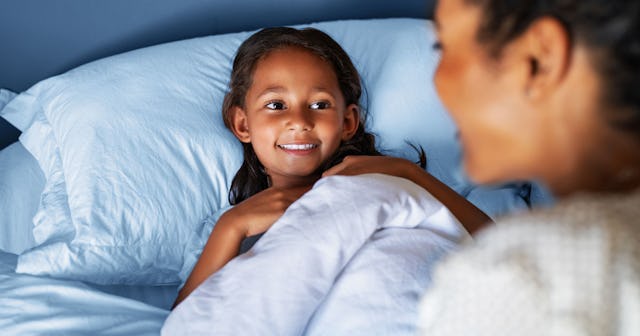Mindfulness Isn't Sorcery––It's Science, And It Helps Kids Sleep Better

This past fall, when my daughters signed into their Google classrooms, I had no idea how this would all pan out. I mean, I could help with their reading and writing. It was about to be super interesting to see what gym looked like remotely. But mindfulness? Meditation? Eh, I’m more of a na-mah-stay in bed kind of mom.
Every day, they were summoned back online after recess, their teachers would practice some kind of mindfulness or breathing exercises to calm and refocus before resuming class. Honestly, I wasn’t sure how effective it really would be. I mean, sometimes I can’t even get my six year old to count all the way to 20 for hide-and-seek. It wasn’t until my daughters discovered the breathing flower (clearly I have no idea of the technical term) on my Apple watch that I realized how much they enjoyed this type of calming routine. If you’ve never seen it, it’s a little flower-like graphic that expands and contracts with each inhale and exhale as it times every breath, calling attention to your breathing patterns.
Every night before bed when we’re tucking in for the evening we take a minute for a guided breathing exercise, compliments of my watch. Crazy enough, it’s nothing I asked them to do. But I’m so glad they’re up for it. It calms them, centers them, and dare I say, helps them fall asleep.
What sorcery is this, you might ask? Better than sorcery — it’s science. Research out from Stanford Medicine supports this: “Children who learned techniques such as deep breathing and yoga slept longer and better.”
I mean, it does make sense. Deep breathing encourages stress relief. Allowing our children to focus on their breathing, filling their lungs, and concentrating on what they’re doing in the present moment can encourage them to let go of other little things that may be bothering them. Just because our children may be small, they still can carry really big worries.
PeopleImages/Getty
My eldest daughter has inherited many of my anxious behaviors. Incorporating mindfulness before bed is the most important part of her routine that I never knew we needed. Often time, especially during the school year, I’d find her nervously fidgeting at bedtime. When I would ask her what was wrong, she would either say “nothing” — or, more often than not, she would launch into a laundry list of things that were on her mind.
Did she turn in her homework? That she already checked twice since logging off. Did she read the right chapters in their book from class? Honey, you’ve already read the entire book. Is tomorrow a spirit day? Child, you wake up at the crack of dawn. There is plenty of time to double-check before you log on. After we’ve answered the litany of questions, she grabs my arm, switches the face of the watch to “breathe”, and presses start.
The first few breaths are short, and then we close our eyes. Long vibrations guide us to breathe in deeply and then out. I’m always curious to see how much lower my heart rate gets after taking these few moments, but the best part is seeing my daughter visibly relax. Mindfulness like this isn’t just good at bedtime. It is a beneficial coping skill for kids to learn and take with them into their tweens, teens, adulthood, and beyond.
I’m glad my children’s school has decided to make mindfulness part of their curriculum. I’ve seen my youngest do belly breathing when she is getting frustrated practicing her writing. I had never heard of it until one day, I asked what she was doing. She explained she puts her hand on her belly and takes really deep breaths, feeling her tummy expand and contract.
Thanks to her 4K and kindergarten experience, mindfulness comes as second nature to her. I’m grateful because literally, I know far too many adults who aren’t even that self-aware. She understands why it makes her feel calm and knows it’s a tool available to help her feel better.
I mean, don’t get me wrong, she is only six and a half. Of course, there are still plenty of epic meltdowns. But since mindfulness has become part of our regularly scheduled program, there’s more mild huffing and puffing than dramatically throwing oneself onto the nearest stationary object.
Settling down before bedtime or working through unpleasant feelings can be hard for everyone, but especially kids. For real, these minions run around like Energizer bunnies even when I feed them all the vegetables and none of the sugar. Little people, I could use some of that. How in the sam hell do you have that energy, sans caffeine?
In the meantime, if you’re able, introduce just a few minutes of mindfulness, yoga, or other relaxation techniques into your kids’ everyday lives. In the long run, it will help them regulate their feelings, recognize what triggers negative emotions, and give them longer and better quality sleep.
Now allow me to rest, relax, and downward dog into a pile of pillows. Because this momma could use a little journaling, mindfulness, and meditation, taking a lesson from my little ones.
This article was originally published on